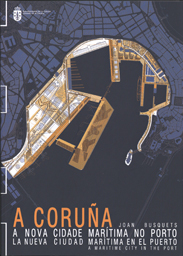A Coruña: A Maritime City in the Port
 A Coruña: A Nova Cidade Marítima No Porto, A Coruña: La Nueva Ciudad Maritima en el Puerto
A Coruña: A Nova Cidade Marítima No Porto, A Coruña: La Nueva Ciudad Maritima en el Puerto
Background
With a view to improving the environmental conditions in which the shipping, handling and temporary storage of certain goods takes place in the port of A Coruña and La Ria, the Port Authority and the State are constructing the outer harbour of Punta Langosteira. The aim of this is to strengthen Spain’s general port system, and to improve and make more dynamic the competitiveness of the transport sector, especially that of Galicia and specifically that of the metropolitan area de A Coruña.
This does not represent the disappearance of the functions of the presentday port, which will continue to operate for shipping that is not transferred, but it will enable the urban restructuring of large spaces that will be freed up in the actual port and on railway land belonging to San Diego station, and their urbanistic integration. The project seeks to improve the city’s seafront and the quality of the urban environment by encouraging interrelation between city, port and sea and obtaining new spaces for civic use, and promoting citizen access to quality social dwellings at affordable prices.
These are the objectives behind the “Agreement for the urban planning of certain tracts of the present-day port of A Coruña and San Diego railway station, with the associated improvements to the urbanistic structure of the city and the construction of new port installations at Punta Langosteira”, which stipulates the bases on which the planned reform is to be structured.
This agreement also envisages, prior to the design of planning instruments, the drafting of a master plan to propose ways of achieving the objectives tabled. This document is a summary of that plan.
Apart from the sectors specified in the agreement, but still in the context of the urban seafront, the document also incorporates As Jubias, which presents a very specific situation, ranging from its difficult relation with city structures to its attractive position beside the ria in A Coruña.
In addition to promoting the creation of important parts of the city, the transformation will also see a return to a natural relation with the expanse of water in the port, freeing up spaces that have until now been inaccessible to most citizens, due to the need, for safety reasons, to restrict free access to port installations. It must also, however, enable a qualitative improvement of urban activity by creating large areas that can be connected to the city’s structure of open spaces and facilities.
The urbanistic scope of the proposals
The master plan seems to lay the bases for this far-reaching urbanistic transformation of the city of A Coruña and its huge area of influence. Although the origins of the city lie in this space around the port, its major development had little to do with the port’s geography. It was only after the dismantling of industrial activity in the port that the city began to establish freer relations with its seafront context.
Below are some of the most relevant actions:
a) Possibility of reusing large spaces of the docks or land platforms in contact with the water. The largeness of these spaces ensures the creation of a new threshold that enables the city to incorporate: 1) central activities which, due to lack of land, have gravitated to the periphery in search of accessibility and low costs; 2) the creation of large facilities and open spaces, and 3) residential areas to respond to the demand for different types of reasonably priced housing.
b) Capacity to restructure existing districts by improving accessibility and connection with the new seafront. Green corridors will ensure their judicious location and development.
c) Improved urban structure with the creation of avenues following the arc of the coast to provide viewpoints near the water and places for people to stroll. The closeness of the various monuments could lead to the creation of an ambitious port promenade like those in some of Europe’s foremost ports, such as Palma, Trieste, Genoa or Amsterdam.
d) However, transformation will also involve recycling important parts of the protected expanse of water, which, though maintaining many present-day activities such as fishing, recreation and passenger traffic, may incorporate many new initiatives that to emerge in the course of the process. The master plan therefore suggests potential spaces for very varied recreation and leisure activities. It even considers the possibility of creating a kind of enclosed lake (beside the Muelle del Centenario wharf) with a constant water level to create a new “aquatic space” with singular emblematic characteristics. By means of this system of uses, the city will be able to recover the attractiveness with which its natural geography endowed it.
The master plan therefore establishes a general urbanistic “vision” to develop the prescriptions of the Agreement, at the same time formulating a transformation strategy that can be implemented by parts, responding to a coherent programmatic logic. Although taking place at different times, they will be connected. In this process it is important for each part to contribute public-use spaces that generate new uses for this duly recovered seafront.
CA Gráfica, 2006